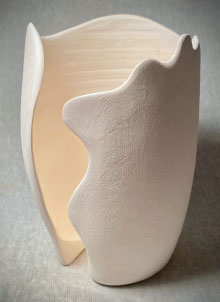It is one thing to see visual artists’ productions in a museum, disconnected from the artists. It is a different experience to talk to them directly and intimately about their work. I recently spent about a month with 80-year-old Ronald Grantham visiting museums in France and discussing different aspects of his pottery. I had come to know him over several generations because of interfamily linkages. He is an architect who established his distinguished reputation over 35 years on the staff of Connecticut architect Warren Platner.
Ron’s primary interest has always been the designing of buildings and interiors. Concerning that passion for design work, he explained that “Everything I look at I’m trying to make it look better.” One of his first love affairs was with Frank Lloyd Wright’s “Falling Water,” which was a home designed by Wright. It was built in 1936 in Millrun, Pa. In his youth, Ron felt an urge to emulate Wright’s work. Once Ron retired from the profession of architecture around 2012, he returned to pottery, something he had started years before, during his architectural training at California State Polytechnic University.
He grew up in the San Francisco area in the 1940s with two siblings. While his mother painted all the time, she and he rarely engaged in deep conversations about art. Still, she encouraged his drawing. Her influence evidently got through to him, as he recalls readily that he enjoyed drawing but did not use color. He was attracted to mechanical drawing classes in high school. In one such class, around 1958, he learned about a contest sponsored by the East Bay Women’s Architectural League. The project task was to design a house for a specific number of occupants and deliver a floor plan, exterior elevations, and a three-dimensional view. He described this activity, noting that he really did not have enough experience to ensure a chance of winning the competition. Still, he never gave up, and with minimal supervision he finished the project. Although he did not win the contest, the experience brought an inner feeling of confidence that he would become an architect.
He obtained his architecture university degree in 1968 and spent a year preparing for the first part of his licensure examinations. He also married his college sweetheart at this time. Then he fulfilled his commitment to the military, serving a two-year stint as an officer in the U.S. Army Corps of Engineers. After discharge, he studied photography for a year, then moved to Connecticut to take up a position with Warren Platner’s firm. It is in this job that he saw his professional skills develop and his creative interests flourish. Ron explained that Platner certainly had his own ideas. However, as a supervisor, Platner also encouraged his staff to indulge their own passions and defend them in open discussions. In this relationship with another artist-architect, Ron participated in the designs of restaurants (such as Windows on the World in New York City), hotels, offices, and private residences.
Ron’s return to pottery during his retirement marked the beginning of personal reflection about his development as a ceramist. He initially worked on bowls and cups, producing what he describes as semi-utilitarian objects. He was not satisfied with the results. Then he moved on to working with white porcelain that obviates use of a glaze. The emphasis on three-dimensional shapes progressively took root. He wanted to emphasize purity of form. He experimented with bending the shapes and polishing the form to smoothness. He avoided texture and use of color. Nowadays, he likes playing with curves and voids, developing contrasts within a single object.
The photograph at right represents his present work. It is a 12-inch-high white sculpture whose primary design element is the spherical shape. The second design element incorporates vertical curves on the right side, reinforced by the smaller curves visible on the top. A contrasting element is the vertical edge on the left side of the opening. The finger lines running horizontally on the inside reinforce the spherical shape of the structure. The white color additionally forces concentration on the three-dimensional structure. It is worth mentioning that Ron signs his work with a simple letter R placed on the outside bottom of the work, to avoid encroachment on the design objective.
He states plainly that his focus is on art for its own sake. He distills satisfaction that is bereft of sociopolitical content. He likes the freedom embodied in the conceptualizing and execution of his sculptures. He experiences a variety of emotions in the creative act. But he does not wish the work itself to contain any message from him, although he concedes that he has no control over what a viewer sees in the finished product. He takes no responsibility for the viewer’s meaning-making. He revels in his personal freedom to contribute to the beauty around us. He can also understand the privilege the artist has in the formulation of aesthetics. I challenge him, saying that he certainly has charted a different route from, for example, Jean-Michel Basquiat, Henri Matisse, or Claude Monet. These are some of the many artists we have discussed recently. He eschews such comparisons. He is pleased with the palpable peacefulness and beauty of his work, with its distance from any social movement. He represents himself. ■


